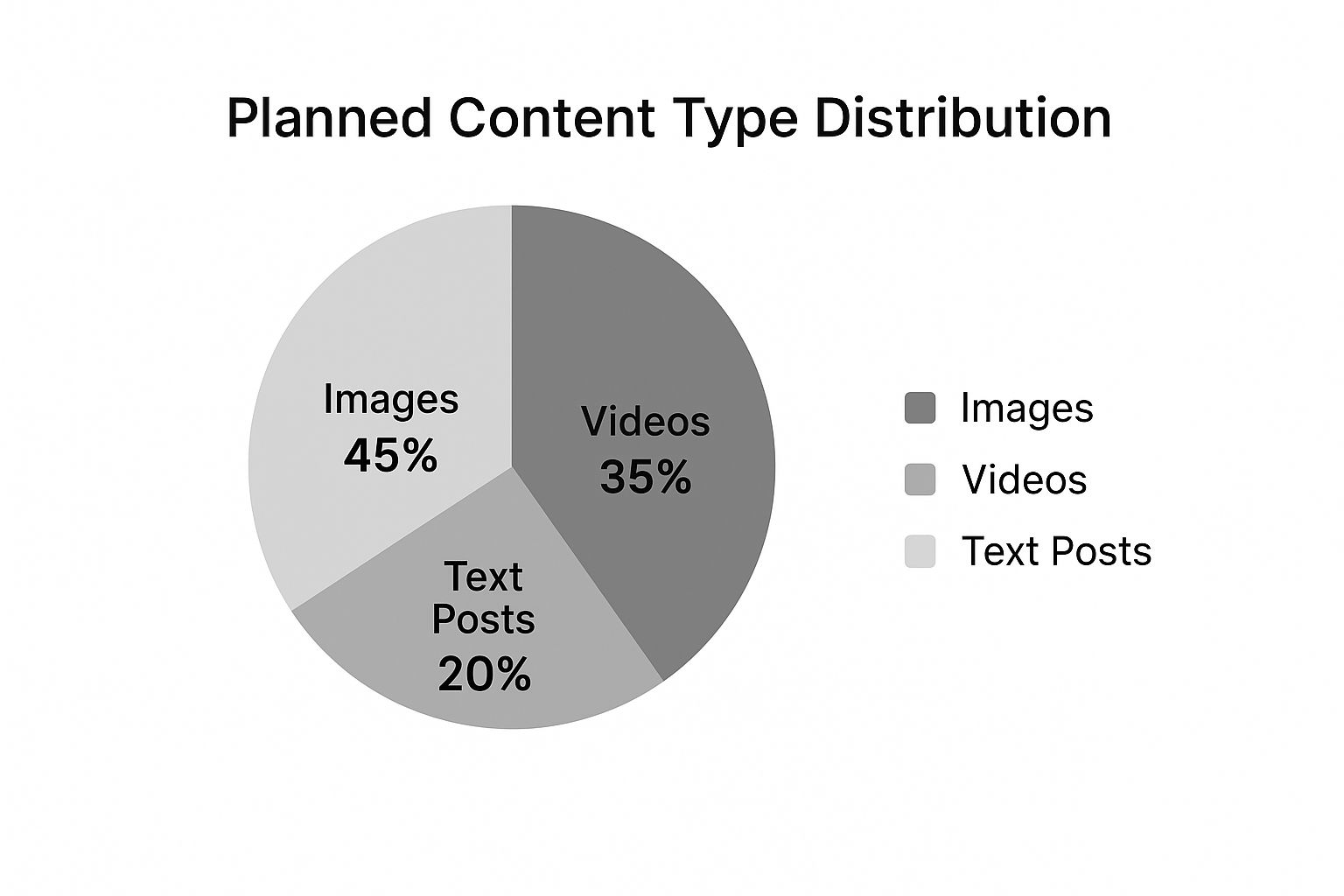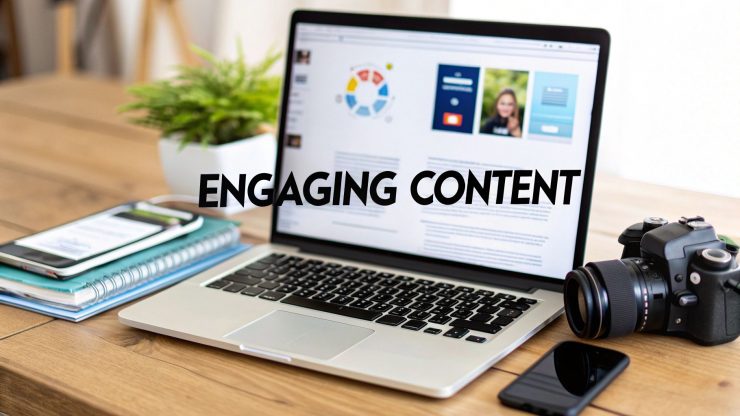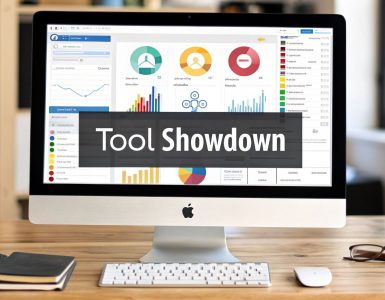If you want to create social media content that actually works, you have to stop thinking about collecting likes and start thinking about sparking conversations. It’s all about giving your audience something of value—whether you're teaching them something, making them laugh, or inspiring them to take action. The real goal is to stop broadcasting messages and start building a real community.
What Actually Makes Social Media Content Engaging?
Before you dive into strategy, you need to get clear on what "engagement" really means in today's world. It's not just a vanity metric; it's the heartbeat of a healthy social media presence. When people engage, it’s a signal that your content is hitting the mark, building trust, and making your brand's connection with its audience stronger. It's what turns a follower into a true fan.
So, what makes someone stop scrolling and interact? It's usually rooted in basic human connection. People are drawn to content that:
- Makes them feel something: Posts that trigger an emotion—laughter, inspiration, even a little bit of outrage—are almost guaranteed to get a reaction.
- Offers genuine value: This could be a quick tip that solves a problem, a fresh perspective on a common topic, or a behind-the-scenes glimpse that’s just plain interesting.
- Lets them express themselves: Think about why memes are so popular. Content that lets people share a piece of their own personality, humor, or identity is incredibly shareable. A relatable post about the chaos of Monday mornings is an easy thing for someone to pass along.
- Asks for their input: Directly asking questions, running polls, or prompting for opinions makes your audience feel like they're part of the conversation, not just watching from the sidelines.
It’s About More Than Just Likes and Follows
Real engagement is a two-way street. It's about comments that blossom into discussions, shares that get your message in front of new eyes, and saves that tell you your content is so good, people want to come back to it. These actions are a much stronger sign of a loyal community than a simple, passive "like."
The mindset shift is simple but powerful: move from broadcasting to conversing. Stop talking at your audience and create space to talk with them. This is the foundation of every great engagement strategy.
The Sheer Scale of the Conversation
It helps to understand just how crowded the social media space is. By 2025, the number of global users is projected to hit over 5.4 billion. The average person already spends around 2 hours and 19 minutes a day scrolling through nearly seven different platforms. With that much noise, your content has to be truly exceptional to stand out.
Ultimately, you need to define what a "win" looks like for your brand on each platform. Are you aiming for deep, thoughtful conversations on LinkedIn? Inspiring saves and shares on Instagram? Or maybe you're chasing viral trends on TikTok? Answering that question is what turns your strategy from a shot in the dark into a smart, data-driven process. To really take your engagement to the next level, it's worth exploring how AI social media content strategies can help you refine your approach and get better results.
Pinpointing Your Audience and Content Pillars

If you try to create content for everyone, you’ll end up connecting with no one. It's the fastest way to get lost in the noise. Before you even think about writing a single post, you have to get crystal clear on who you're talking to.
This isn’t about broad demographics. It's about painting a vivid picture of a real person—someone with genuine needs, specific problems, and real motivations.
Let’s say you run a local coffee shop. A basic audience profile might be "women, 25-40." That’s a start, but it’s not enough. A detailed persona, on the other hand, describes "Busy Sarah." She's a 32-year-old freelance graphic designer who's desperate for a quiet morning spot with solid Wi-Fi. See the difference? That simple shift changes your content from a generic "buy our coffee" message to a post that showcases your cozy corners and free, reliable internet.
Building Your Audience Personas
To really nail your social media content, you have to dig deep into your audience's world. The best way to do this is by creating a few core personas. These are fictional characters, but they represent your ideal customers and will become the north star for every content decision you make.
Start by asking some pointed questions:
- What are their pain points? What daily frustrations are they dealing with that you can solve? For "Busy Sarah," it’s the struggle to find a productive workspace that isn’t her distracting home office.
- What are their motivations? What drives them? She wants to grow her business and needs a professional-yet-casual spot to meet clients.
- Where do they hang out online? Which social platforms do they actually use, and what kind of content do they engage with? Sarah probably follows productivity influencers on Instagram and connects with other freelancers on LinkedIn.
Knowing your audience isn't just about targeting ads better. It's about creating content that makes people feel seen, understood, and valued. When someone feels like you’re speaking directly to them, they’re infinitely more likely to listen and engage.
Establishing Your Core Content Pillars
Okay, you know who you're talking to. Now it's time to figure out what you'll talk about. This is where content pillars come in. These are the 3-5 core themes or topics your brand will consistently discuss. Think of them as a strategic filter, making sure every post is relevant to your brand and genuinely useful to your audience.
For our coffee shop targeting "Busy Sarah," the pillars might look something like this:
- The Productivity Hub: Content about creating the perfect work-from-anywhere setup, featuring your shop's best seats, outlets, and quiet corners.
- Community Connection: Posts that highlight local artists whose work is on your walls, other freelancers who frequent your shop, or community events you're hosting.
- Coffee Craftsmanship: Take people behind the scenes. Show them where your beans come from, introduce your baristas, and share tips for the perfect brew.
This structured approach stops your feed from feeling like a random collection of photos and turns it into a cohesive, value-packed experience. It not only simplifies your content planning but also builds a predictable, trustworthy brand voice that keeps people coming back.
If you feel stuck trying to fill these pillars, we've got a guide on how to brainstorm new social media ideas that can get the creativity flowing.
Choosing Content Formats for Maximum Impact
The same idea can either sink or swim based entirely on how you present it. Deciding on the right content format isn't just about aesthetics; it's a strategic move that can make or break your engagement.
A brilliant insight shared as a simple text post on Instagram might get lost in the noise. But what if you transformed that same insight into a swipeable carousel? Suddenly, you could be looking at hundreds of saves and shares. That's the power of the right package.
This is the secret to working smarter, not harder. Instead of constantly chasing brand-new ideas, you can take one solid concept and adapt it into multiple formats. This way, you squeeze every last drop of value from your creative efforts and get your best ideas in front of the widest possible audience.
Matching the Format to the Platform
Every social media platform has its own vibe, its own culture, and its own set of user expectations. A format that gets amazing results on one can feel completely out of place on another. Getting this right is the key to creating content that feels like it truly belongs in someone's feed.
Think about it this way:
- Instagram: Yes, Reels are huge, but don't sleep on high-quality photos and carousels. I’ve found carousels are absolute gold for breaking down complex topics into simple, digestible slides. They're a save-magnet for educational content.
- TikTok: This is the undisputed home of short, authentic video. Trends, quick tutorials, and behind-the-scenes content do incredibly well here. Forget about high-production value; personality is what counts.
- LinkedIn: Professional value is the name of the game. People are there to learn and grow their careers. Text posts sharing industry insights, carousels that summarize a report, or a short video with a solid career tip will always outperform a meme.
- X (formerly Twitter): It's all about brevity and sparking conversation. Short text posts, threads that unpack a big idea one piece at a time, and timely memes can really get people talking.
The best content doesn't just exist on a platform; it feels like it was made for that platform. When you tailor your format, you're showing your audience you understand the culture and you respect their time.
The data backs this up. In 2025, TikTok is still leading the pack with an organic engagement rate of 2.50%, thanks to its algorithm's love for shareable video. But over on Instagram, it's a different story. Photo posts for business accounts actually see the highest engagement at 2.69%. It’s a perfect example of why knowing which format works best where is such a critical piece of the puzzle.
Platform Engagement by Content Format
This table compares the average engagement rates of different content formats across major social media platforms, helping you prioritize your content creation efforts.
| Platform | Top Performing Format | Average Engagement Rate | Secondary Format |
|---|---|---|---|
| Photo | 2.69% | Carousel | |
| TikTok | Short-Form Video | 2.50% | Live Video |
| Text Post | 1.78% | Document (Carousel) | |
| X (Twitter) | GIF/Meme | 0.95% | Thread |
As you can see, what works wonders on one platform might just be average on another. This data should guide your decisions on where to invest your time and creative energy.
Visualizing Your Content Mix
A healthy content plan needs variety. You have to mix things up to keep your audience interested and your feed from feeling stale. The image below gives you a great visual for what a balanced content distribution often looks like.

It’s clear that a strategic blend, with a heavy lean towards compelling images and videos, should be the foundation of any strong content schedule.
How to Repurpose One Idea into Multiple Formats
Let's make this practical. Say your core idea is a simple but useful tip: "3 ways to improve your morning productivity." Instead of just firing off one post and calling it a day, you can turn this into a whole week's worth of content.
Here's how I'd do it:
- For Instagram: Design a clean, eye-catching carousel. Use the first slide as a strong hook, and then dedicate each of the following slides to one of the three tips. Easy to read, easy to save.
- For TikTok: Grab your phone and film a quick, 15-second video. You can act out each tip or just point to text on the screen while a trending audio clip plays. Keep it fast and energetic.
- For LinkedIn: Write a concise text-only post. Start with a personal story about how you used to struggle with mornings, then share the three tips that changed everything for your workday. Make it relatable.
This multi-format approach is a game-changer. You’re no longer just posting; you're strategically communicating across different channels, meeting your audience where they are. It’s a foundational strategy you'll want to master as you create a comprehensive social media plan.
Crafting Visuals and Copy That Stop the Scroll

You have a split second. That’s it. In a feed that never ends, your visual and the first line of your copy are everything. They’re your one shot to make someone pause their thumb and pay attention to what you have to say.
Getting this right is the heart of creating truly engaging social media content. It isn't about shouting the loudest; it's about being the most compelling voice in the room.
Designing Thumb-Stopping Visuals
Let's be real: visuals do the heavy lifting. Our brains process images 60,000 times faster than text, so your graphic or video makes the first impression long before anyone reads a word. The good news? You don't need a fancy design degree to create something effective.
Just stick to these core ideas:
- Clarity Over Clutter: A single, sharp image with a clear focal point beats a busy, confusing graphic every time. Give your message room to breathe with plenty of white space.
- Brand Consistency: Stick to your brand’s colors, fonts, and logo. This isn't just about looking professional; it's about building instant recognition in a crowded feed.
- Human Connection: People connect with other people. Ditch the generic stock photos and use images of your actual team or happy customers. Those real faces build real trust.
The goal of a social media visual isn't just to be seen; it's to be felt. Your image should spark an emotion or a question, making someone stop and want to know more.
Writing Copy That Connects
Once your visual has earned that pause, your copy has to seal the deal. The best social media copy is simple, direct, and sounds like it was written by a human for another human.
The very first sentence—your hook—is make-or-break. It must demand attention. Instead of a bland "We're excited to announce our new product," try hitting a nerve: "Tired of your coffee getting cold in five minutes?" The second one talks directly to a problem and makes you lean in.
After a killer hook, make your caption easy on the eyes. Use short sentences, plenty of line breaks, and even an emoji or two to break up the text. It makes the whole thing much easier to scan and absorb on a tiny screen.
Mastering the Call-to-Action
Every single post needs a job to do. Your call-to-action (CTA) is you telling your audience what that job is. Vague CTAs like "learn more" are just background noise people have learned to ignore.
Be specific and show them what's in it for them.
- Weak CTA: "Check out our new blog post."
- Strong CTA: "Tap the link in our bio to get 3 productivity tips you can use today!"
This approach works because it gives people a clear reason to click. A strong CTA doesn't just ask for something; it promises value in return. That's the key to creating engaging content that actually drives results.
If you really want to see scroll-stopping content in action, look at how brands are using influencers to create authentic, dynamic visuals. Understanding how to find TikTok influencers can offer a masterclass in what kind of personality-driven content truly connects with people right now, adding a powerful human element to your own strategy.
How to Analyze and Optimize Your Content Strategy

If you're creating content without ever looking back at how it performs, you're essentially guessing in the dark. You might hit the mark occasionally, but a data-driven approach is the only reliable way to build a strategy that actually works and grows a loyal community.
The trick is to look past the surface-level numbers. Sure, a high like count feels great, but the metrics that signal a real connection—like shares, comments, and saves—are where the gold is. These actions mean your content resonated so strongly that someone felt compelled to keep it or pass it along to their own network.
Digging into Your Platform Analytics
Every major social media platform has its own built-in analytics, and they're surprisingly powerful if you know where to look. Your job is to get comfortable with them. Don't just check your follower count and call it a day; you need to dive into the post-by-post breakdowns to find out what's really going on.
Start by spotting the patterns in your best-performing content. Get curious and ask yourself a few questions:
- What was the format? Was it a carousel, a quick video, or maybe just a text-only post?
- What was the topic? Did you share a helpful tip, tell a personal story, or offer a behind-the-scenes glimpse?
- What was the tone? Was it funny and lighthearted, purely educational, or more on the inspirational side?
Just running through this simple exercise will start to show you what your audience genuinely enjoys. You can also use these tools to figure out the exact days and times your followers are online and scrolling, which gives you a huge advantage when you schedule future posts.
The most engaging social media content is never an accident. It comes from a constant cycle of posting, listening to what the data tells you, and tweaking your approach based on what truly connects with people.
The Metrics That Matter Most
It's easy to get fooled by vanity metrics. A post can rack up a thousand likes but generate zero comments or, more importantly, zero clicks to your website. To get a real feel for your engagement, you have to focus on the numbers that show active participation.
Here are a few key performance indicators to keep an eye on:
- Save Rate: This is the percentage of people who saw your post and saved it. It’s a massive signal that you created something valuable enough for them to want to come back to later.
- Share Velocity: This measures how quickly a post gets shared after you publish it. A high velocity can catch the algorithm's attention, pushing your content out to a much wider audience.
- Comment Sentiment: Don't just count the comments; read them. Are people asking thoughtful questions? Are they starting genuine discussions? That's what you want to see.
Conducting a Simple Monthly Audit
Make it a habit to set aside some time each month to review your performance. A monthly audit doesn't need to be some complicated, spreadsheet-heavy task. Just open up your analytics and answer three simple questions: What worked? What didn't? And what are we going to try next month?
This regular check-in helps you double down on what’s hitting the mark and confidently phase out what isn't. It's a fundamental part of building an effective, long-term plan. For anyone looking to go a bit deeper, we have a guide that offers more ways to improve your social media strategy with some really practical insights. This continuous loop of analysis and adjustment is how your efforts get smarter and more effective over time.
Common Questions About Social Media Content
Even with the best strategy in place, you're bound to hit a few questions once you start getting your hands dirty creating content. Let's walk through some of the most common ones I hear. Getting these fundamentals right is a huge part of learning how to create social media content that actually connects with people and gets results.
How Often Should I Post to Keep My Audience Engaged?
I wish there was a magic number, but the truth is, it really depends on the platform and your specific audience. What works on one network might totally flop on another.
For a fast-moving feed like X (formerly Twitter) or TikTok, you can often get away with posting 1-3 times a day without overwhelming anyone. On the other hand, a good starting point for Instagram and Facebook is usually around 3-5 quality posts per week. LinkedIn is a bit more professional, so 2-3 times weekly is often plenty.
The golden rule here is consistency over quantity. I've seen it time and time again: it's so much better to share three amazing, well-thought-out posts a week than to spam your followers with seven mediocre ones that nobody interacts with.
Your best bet? Dig into your analytics to see when your audience is actually online. Test a few different posting schedules and pay close attention to what drives the most engagement without burning out your followers.
What Are the Best Free Tools for Creating Social Media Content?
You absolutely do not need a huge budget to make your content look sharp and professional. There are some fantastic free tools out there that can completely change the game for your social media presence.
Here are a few of my go-to recommendations:
- Canva: This is the undisputed champ for a reason. Its massive library of templates and drag-and-drop interface makes graphic design a breeze, even if you've never designed anything before.
- CapCut: If you're creating short-form video (and you should be!), this app is a must-have. It's packed with powerful features like auto-captions and trending effects, and it's completely free.
- Adobe Express: For those who need a bit more control, Adobe's free plan offers some seriously robust photo editing and design tools. It’s a great way to create high-quality visuals without the price tag.
These tools make it possible for anyone to create great-looking content, regardless of their budget or design experience.
How Can I Encourage More Comments on My Posts?
Getting a conversation started is all about giving people a reason to talk. Engagement is a two-way street, so you have to actively invite your audience to join in.
Try ending your captions with a simple, open-ended question. Instead of just showing off a new product, you could ask, "What’s the first thing you’d do with this?" or "Which color is your favorite?" It’s a small change that makes a huge difference.
Interactive features are your best friend here. Use the poll and quiz stickers in your Stories—they're a low-effort way for people to participate. Most importantly, show up in your own comments section! When you reply to people and ask follow-up questions, it signals that you’re actually listening and value their input, which encourages more people to chime in next time.
Ready to put your content strategy on autopilot? With EvergreenFeed, you can automatically schedule your best content, save hours of manual work, and keep your audience engaged around the clock. Start your free trial today and see the difference.




